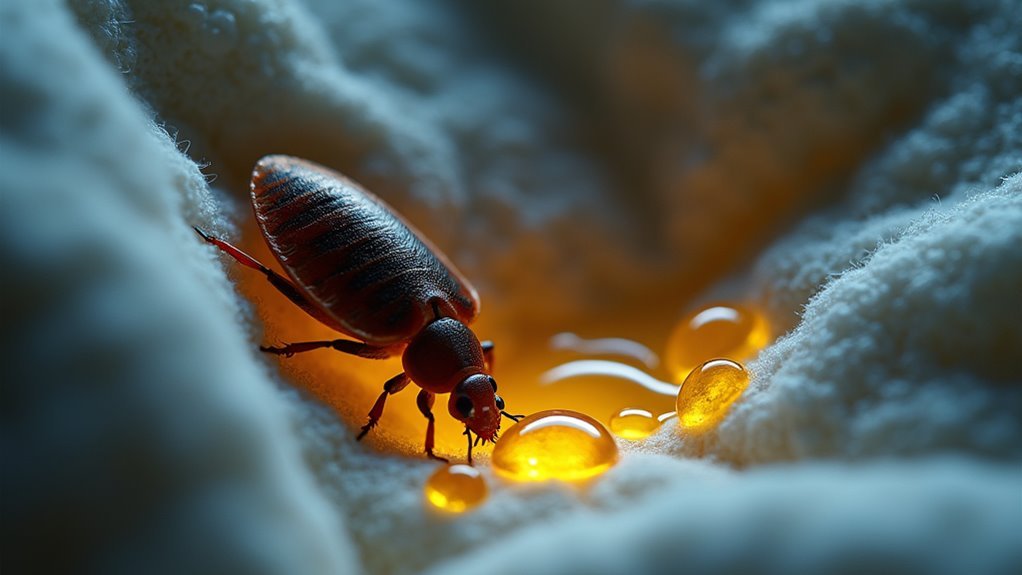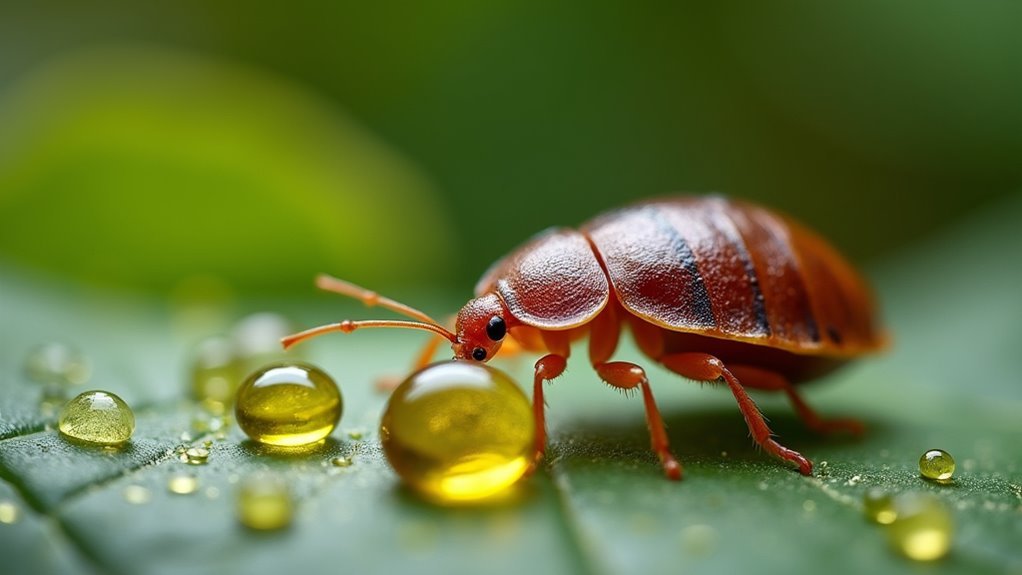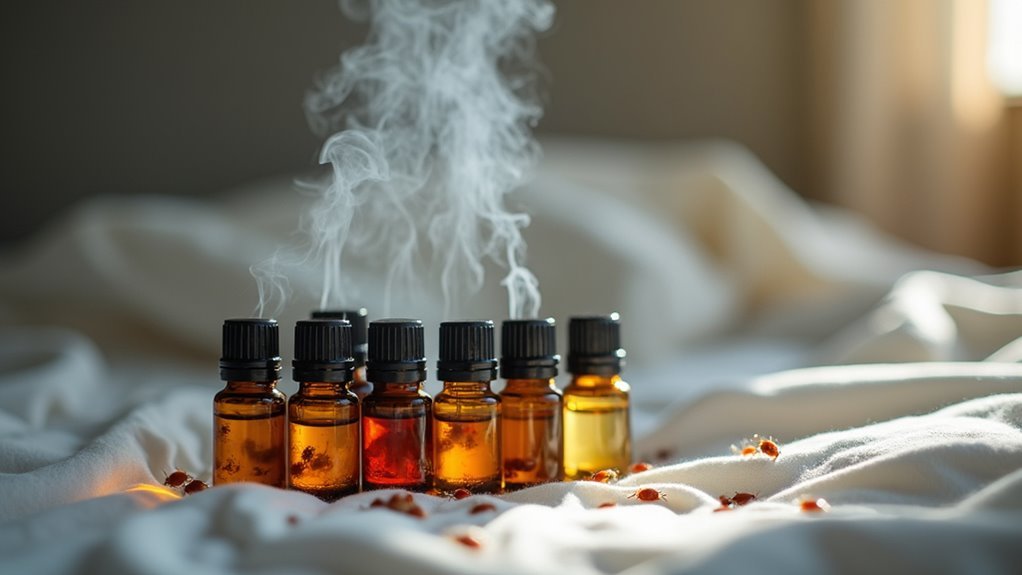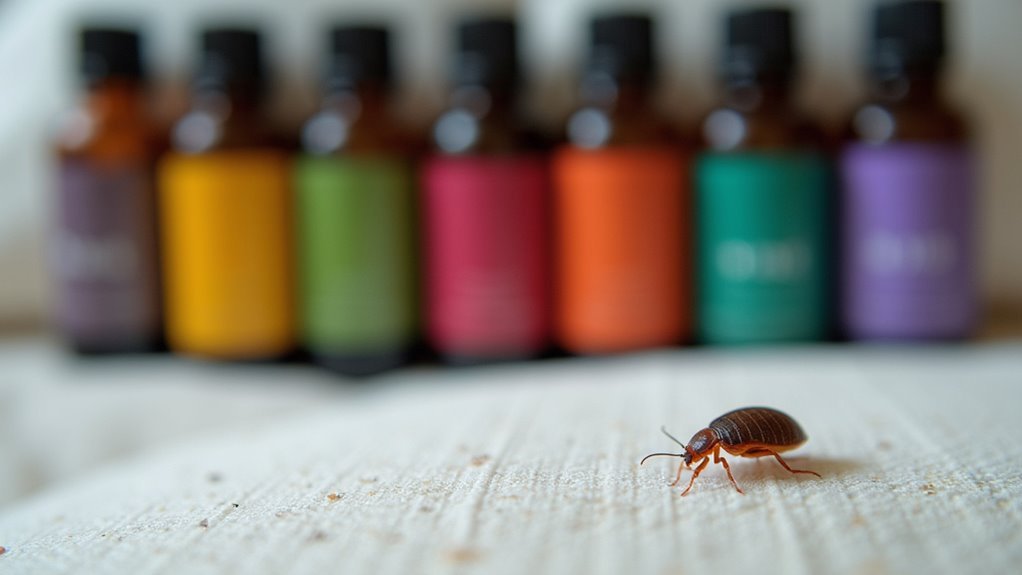Essential oils fail against bed bugs because they require concentrations up to 70,000 times higher than synthetic insecticides to be lethal. You’ll find that bed bugs’ tough chitinous exoskeletons block penetration, while their overactive enzymes break down natural compounds. These oils evaporate quickly, providing no residual protection, and repeated exposure allows bugs to develop tolerance. High concentrations needed for effectiveness pose safety risks to you and your family. Understanding these limitations reveals why professional treatments deliver superior results.
The Science Behind Essential Oil Pest Control Claims

While essential oils can disrupt bed bug nervous systems, you’ll need concentrations up to 70,000 times higher than synthetic insecticides to achieve the same lethal effects.
Research shows that compounds like thymol and carvacrol do produce neuroinhibitory effects on bed bugs, but their practical application falls short of effective pest control standards.
While thymol and carvacrol demonstrate neurological impact on bed bugs, their effectiveness remains insufficient for professional pest control applications.
You’re dealing with variable results that rarely eliminate entire infestations. Unlike synthetic insecticides designed for persistent action, essential oils provide no residual protection once they’ve dried.
The doses required for actual mortality are impractical in real-world scenarios, forcing you to combine them with more potent treatments.
When bed bugs have already developed resistance mechanisms against commercial pesticides, essential oils become even less viable as standalone solutions for serious infestations.
Concentration Requirements vs. Practical Application
You’ll face a stark reality when comparing the concentrations needed for essential oils versus synthetic insecticides – essential oils require up to 70,000 times higher concentrations to achieve the same lethal effects on bed bugs.
This massive dosage gap creates serious practical limitations, as the amounts you’d need to apply in your home would likely pose health risks to you, your family, and pets.
The concentrations that actually work in laboratory settings simply aren’t safe or feasible for real-world residential use, leaving you with diluted solutions that won’t effectively eliminate your bed bug problem.
Massive Dosage Gaps
Although essential oils show promise in laboratory studies against bed bugs, the concentration requirements create an enormous practical barrier for homeowners.
You’d need up to 70,000 times more essential oil than synthetic insecticides to achieve similar lethality – a staggering difference that makes effective pest control nearly impossible with natural alternatives.
The dosage gaps between essential oils and conventional treatments reveal why these natural solutions consistently fail in real-world applications:
- Some essential oils require concentrations so high they’d irritate your skin and respiratory system in enclosed spaces.
- Variable potency means you can’t predict how much you’ll actually need for different bed bug strains.
- Even the most promising fumigant oils still need 400 times higher concentrations than synthetic options.
These massive dosage requirements make essential oils impractical for serious infestations.
Real-World Application Limits
Beyond the sheer volume of essential oils needed, the concentration requirements create impossible scenarios when you try to implement these treatments in your actual living space.
Real-world application becomes impractical when you consider that effective concentrations would saturate your home with overwhelming scents and potentially toxic levels. You’d need to apply these oils so frequently that your living environment becomes uninhabitable for humans and pets alike.
The limited effectiveness of essential oils against bed bugs means you’re constantly reapplying treatments that barely make a dent in the infestation.
You’ll find yourself trapped in an endless cycle of frequent reapplication, spending more money and time while the bed bug population continues thriving in your home.
Bed Bug Resistance Mechanisms to Natural Compounds

You’ll find that bed bugs don’t just resist synthetic pesticides—they’ve also developed sophisticated defenses against natural compounds like essential oils.
Their enzymatic defense systems, particularly overactive cytochrome P450 enzymes, can break down and neutralize many plant-based compounds before they cause lethal damage.
This natural compound tolerance means you’re facing the same resistance challenges with essential oils that you encounter with traditional insecticides.
Natural Compound Tolerance
While bed bugs have garnered attention for their resistance to synthetic insecticides, they’ve also developed concerning tolerance mechanisms against natural compounds found in essential oils.
You’re dealing with insects that possess genetic adaptations allowing them to neutralize or degrade active compounds in these natural solutions.
Research reveals that bed bugs can develop tolerance to natural compounds just as they do with synthetic chemicals.
Here’s what you need to know about their defense mechanisms:
- Overactive enzymes break down essential oil compounds before they become lethal
- Genetic mutations help bed bugs neutralize natural active ingredients
- Tolerance develops over repeated exposure, reducing long-term effectiveness
You’ll find that lethal doses of essential oils can be 70,000 times higher than synthetic insecticides, demonstrating these tolerance mechanisms’ effectiveness against natural compounds.
Enzymatic Defense Systems
The most notable factor behind bed bugs’ tolerance to natural compounds lies in their sophisticated enzymatic defense systems. You’re dealing with insects that possess overactive cytochrome P450 enzymes, which don’t just break down synthetic pesticides like deltamethrin—they also neutralize essential oils’ active constituents. These enzymatic defenses force you to use considerably higher concentrations to achieve any lethality against resistant strains.
| Defense Mechanism | Impact on Treatment |
|---|---|
| Cytochrome P450 overactivity | Degrades both synthetic pesticides and natural compounds |
| Enhanced metabolic processing | Neutralizes essential oil constituents before toxicity occurs |
| Cross-resistance development | Reduces effectiveness across multiple treatment types |
| Enzymatic upregulation | Requires considerably higher concentrations for lethality |
| Adaptive metabolism | Makes bed bugs increasingly tolerant over time |
You’ll find combining essential oils with synthetic treatments can help overwhelm these enzymatic defenses.
Penetration Problems Through Bed Bug Exoskeletons
Although essential oils show promise in laboratory settings, bed bugs’ tough chitinous exoskeletons create a formidable barrier that greatly reduces these natural compounds’ effectiveness.
Bed bugs’ chitinous armor acts as a natural shield, blocking essential oils from penetrating deep enough to be truly effective.
When you apply essential oils against bed bugs, you’re fighting against penetration issues that stem from their waxy exterior coating, which repels liquid compounds before they can reach the pest’s nervous system.
The challenge becomes even more pronounced when you consider that bed bug exoskeletons require essential oils to achieve considerably higher concentrations than synthetic insecticides to deliver lethal doses.
This creates three major obstacles:
- Essential oils can’t penetrate the chitin barrier effectively
- Higher concentrations are needed but rarely achieved in practical applications
- Sub-lethal exposures allow bed bugs to recover quickly and continue reproducing
Rapid Dissipation and Limited Residual Effects

You’ll notice that essential oils evaporate quickly after application, which means their insecticidal effects don’t last long in your treated areas.
Unlike synthetic pesticides that can remain active for weeks or months, essential oils lose their potency within hours due to their volatile nature.
This rapid dissipation forces you to reapply treatments frequently, making them impractical for long-term bed bug control.
Quick Evaporation Problem
When essential oils come into contact with air, their volatile compounds begin evaporating almost immediately, creating a fundamental challenge for bed bug control. This quick evaporation means you’re constantly losing the active compounds that make these oils potentially effective against pests.
The volatile nature of essential oils works against you in several ways:
- Concentration dilution – You’ll need considerably higher amounts compared to synthetic insecticides to achieve similar results.
- Penetration failure – Evaporating oils can’t effectively breach bed bugs’ protective exoskeleton.
- Population control issues – Without sustained presence, oils fail to manage severe infestations.
These limited residual effects force you into constant reapplication cycles. Unlike conventional treatments that maintain effectiveness for weeks, essential oils lose their potency within hours, making them impractical for serious bed bug problems.
Short-Term Protection Only
Since essential oils dissipate rapidly after application, you’re left with protection that lasts mere hours rather than the weeks or months you’d get from professional treatments.
This short-term protection means you’ll need constant reapplication to maintain any deterrent effect against bed bugs. The volatile nature of these compounds causes their effectiveness to plummet within hours, leaving your home vulnerable to reinfestation.
While you might notice initial repellency, bed bugs can quickly return once the oils lose potency.
Professional treatments create lasting barriers that continue working for extended periods, whereas essential oils require you to repeatedly treat areas throughout the day. This constant maintenance makes them impractical for serious bed bug control.
Variable Potency Across Different Essential Oil Types
While essential oils offer a natural approach to bed bug control, their effectiveness varies greatly depending on the specific type you choose. Research reveals stark differences in potency across oil varieties. Carvacrol and thymol demonstrate high toxicity levels against bed bugs, while lavender and tea tree oils show minimal impact.
The concentration requirements highlight these disparities – some essential oils need up to 70,000 times more product than synthetic insecticides to achieve comparable results.
Studies show inconsistent performance patterns:
- Eugenol and citronellol exhibit strong fumigant properties
- Many oils fail to kill bed bugs within 24-hour exposure periods
- Application method and bed bug strain greatly influence outcomes
This variability means you can’t rely on essential oils as consistent bed bug solutions, making professional treatments more dependable choices.
Cost Analysis: Essential Oils vs. Professional Treatment
Beyond effectiveness concerns, the financial reality of using essential oils for bed bug control presents significant drawbacks compared to professional treatments.
You’ll find that high-quality essential oils exceeding $50 per bottle require frequent applications and higher concentrations, causing costs to accumulate rapidly.
This cost analysis reveals that while professional treatments range from $100 to $500, they’re often more economical long-term.
Professional pest control services utilize targeted insecticides that effectively eliminate bed bug infestations, whereas essential oils provide only temporary relief.
You’re risking prolonged infestations that can double your overall expenses when relying solely on essential oils.
Professional treatments include thorough eradication plans and follow-up visits, delivering superior value that DIY approaches can’t match.
Safety Risks of High-Concentration Essential Oil Use
Although essential oils might seem like a natural, safer alternative to chemical pesticides, using them at high concentrations creates serious health risks that many homeowners don’t anticipate.
When you apply undiluted essential oils directly to your skin, you’re risking burns, dermatitis, and severe skin irritation. High concentrations can also trigger allergic reactions and respiratory problems, especially in enclosed bedrooms where you’re sleeping.
Key safety risks include:
- Skin burns and dermatitis from undiluted application
- Respiratory tract irritation in enclosed spaces
- Toxicity dangers for pets and children
You must always dilute essential oils with carrier oils before skin contact.
Using large amounts during sleep won’t boost effectiveness against bed bugs but will increase your risk of adverse reactions and heightened sensitivity.
Why Bed Bugs Develop Tolerance to Plant-Based Compounds
Beyond the immediate health concerns of using high-concentration essential oils, bed bugs present another challenge that undermines long-term treatment success: they’re remarkably adaptable creatures that can develop tolerance to plant-based compounds.
Genetic mutations enhance their ability to detoxify these substances through overactive cytochrome P450 enzymes. Research shows resistant bed bugs demonstrate notably reduced sensitivity to essential oils compared to non-resistant strains.
Resistant bed bugs produce elevated detoxifying enzymes that dramatically reduce their vulnerability to essential oil treatments compared to susceptible populations.
You’ll find that continuous exposure increases the frequency of resistance mechanisms within populations, making eradication efforts more complex. Essential oils require higher concentrations over time as bed bugs adapt.
Additionally, these pests develop behavioral resistance, learning to avoid treated areas entirely. This evolutionary response makes essential oils increasingly unreliable for long-term bed bug control.
Environmental Factors That Reduce Essential Oil Effectiveness
While bed bugs’ adaptive capabilities pose significant challenges, environmental conditions create equally problematic obstacles that compromise essential oil treatments. High humidity dilutes essential oils, reducing their potency and pest control effectiveness. Temperature fluctuations increase evaporation rates, causing oils to dissipate before they can impact bed bugs. Sunlight exposure degrades active compounds over time, weakening their repellent properties.
Environmental factors that diminish treatment success include:
- Organic material and debris absorbing oils, reducing concentration in target areas
- Poor air circulation dispersing oil molecules away from infested zones
- Moisture accumulation diluting active compounds and shortening treatment duration
You’ll find these conditions particularly challenging in cluttered bedrooms, basements with poor ventilation, or areas with inconsistent climate control.
Understanding these environmental limitations helps explain why essential oils often fail as standalone bed bug solutions.
The 70,000x Concentration Gap Compared to Synthetic Insecticides
Research reveals a staggering reality that exposes the fundamental weakness of vital oils against bed bugs: they require concentrations 70,000 times higher than synthetic insecticides to achieve comparable lethal effects. This massive concentration gap demonstrates why your vital oil treatments consistently fail where synthetic pest control products succeed.
| Treatment Type | Required Concentration | Effectiveness | Safety Concerns |
|---|---|---|---|
| Essential Oils | 70,000x higher | Minimal impact | High at lethal doses |
| Synthetic Insecticides | Standard formulation | Proven lethal | Regulated levels |
| Pyrethroids | Low concentration | Highly effective | Established protocols |
While essential oils can disrupt bed bug nervous systems, they’re fundamentally outmatched by synthetic insecticides designed specifically for pest control. You’re basically fighting with a water gun against armor-piercing ammunition when choosing essential oils over conventional treatments.
How Essential Oil Marketing Misleads Consumers
This massive gap in effectiveness creates fertile ground for misleading marketing tactics that prey on consumers seeking natural alternatives. Companies promoting essential oils for bed bug control often make bold claims about complete eradication without scientific backing.
They emphasize “natural” ingredients while conveniently omitting vital limitations like inconsistent efficacy and resistance development.
These deceptive practices create three major problems:
- Consumers believe essential oils can fully replace professional treatments
- Marketing downplays the need for integrated pest management strategies
- Anecdotal claims substitute for rigorous scientific testing results
You’re led to believe that effective essential oils can solve your infestation independently, when research shows they work better as deterrents.
This misleading marketing prevents you from implementing thorough solutions that combine multiple approaches for actual bed bug elimination.
Evidence-Based Alternatives That Actually Work
After recognizing the limitations of essential oils, you need proven alternatives that deliver actual bed bug eradication.
Synthetic insecticides specifically formulated for bed bugs, particularly pyrethroids, provide the potency that essential oils simply can’t match. These targeted treatments effectively eliminate all life stages, even when dealing with resistant strains.
Heat treatment offers another chemical-free solution by raising temperatures to lethal levels throughout infested areas. This method guarantees complete elimination without relying on potentially ineffective natural remedies.
Professional pest control services deliver thorough treatment plans using advanced techniques unavailable in DIY approaches. They implement integrated pest management strategies, combining multiple methods like insecticides with steam cleaning or diatomaceous earth.
For effective pest control, you’ll achieve better results by investing in scientifically-backed solutions rather than hoping essential oils will solve your infestation.
Frequently Asked Questions
What Essential Do Bed Bugs Hate?
You’ll find bed bugs hate thymol, carvacrol, and eugenol most effectively. They also dislike citronella and geraniol oils. While lavender and peppermint provide some repellent properties, they’re not as potent against these persistent pests.
Why Is It so Hard to Get Rid of Bed Bugs?
You’re facing rapid reproduction rates, pesticide resistance, months-long survival without feeding, and their ability to hide in tiny spaces. These factors combine making bed bug elimination extremely challenging.
What Does Peppermint Oil Do to Bed Bugs?
Peppermint oil temporarily deters bed bugs by masking your scent and creating a cooling sensation they dislike. However, it won’t kill them or eliminate infestations, making it ineffective for serious bed bug control.
What Is the Best Essential Oil Spray for Bed Bugs?
You’ll find thymol, carvacrol, and eugenol-based sprays most effective. Mix 10-15 drops with rubbing alcohol and distilled water, but don’t expect complete eradication—you’ll need frequent reapplication and professional treatment.
In Summary
You’ve seen the evidence: essential oils can’t deliver the concentrated doses needed to kill bed bugs effectively. They dissipate quickly, can’t penetrate exoskeletons properly, and you’d need impractically high concentrations to see real results. Don’t fall for marketing claims that ignore basic chemistry. Instead, you’ll get better results with proven integrated pest management approaches that combine professional treatments, heat, and targeted synthetic insecticides designed specifically for bed bug elimination.





Leave a Reply